Unit 1 Lesson 2 It’s Getting Warmer课件 (共20张PPT)冀教版英语八年级下册
文档属性
| 名称 | Unit 1 Lesson 2 It’s Getting Warmer课件 (共20张PPT)冀教版英语八年级下册 |
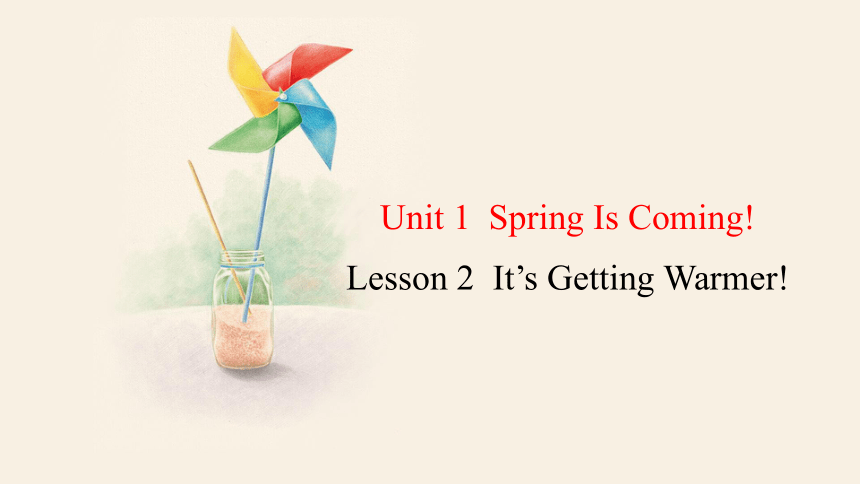
|
|
| 格式 | pptx | ||
| 文件大小 | 619.0KB | ||
| 资源类型 | 教案 | ||
| 版本资源 | 冀教版 | ||
| 科目 | 英语 | ||
| 更新时间 | 2023-12-28 11:48:15 | ||
图片预览

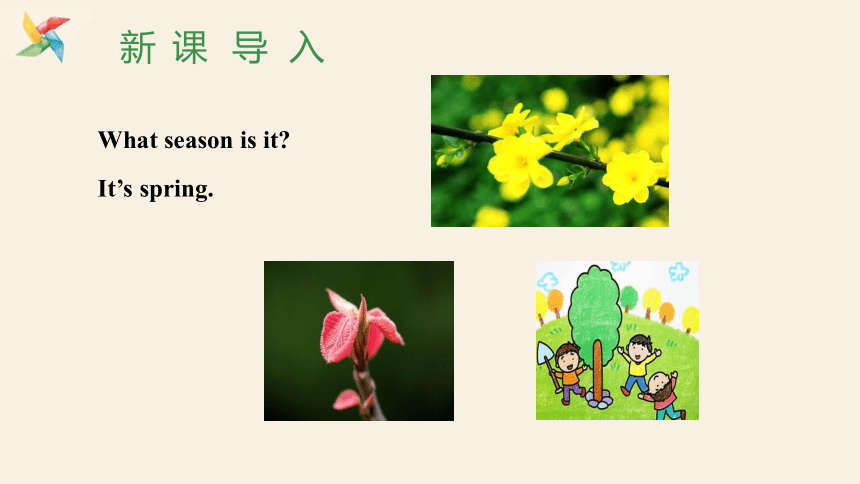
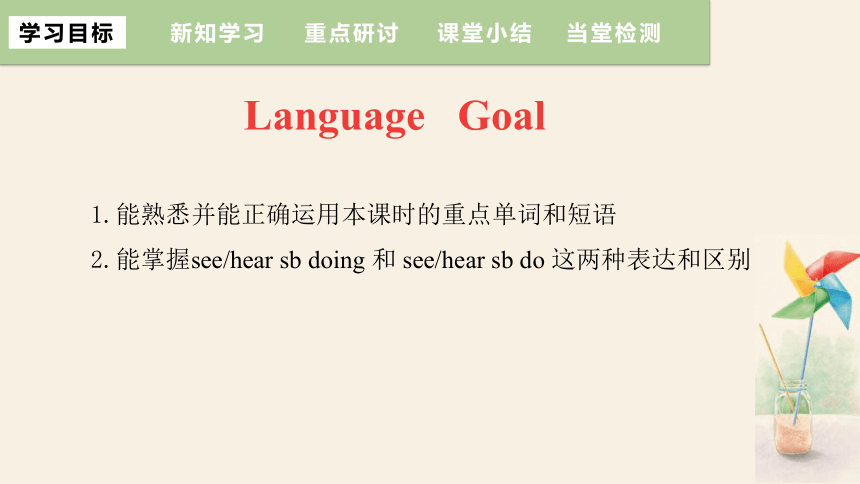
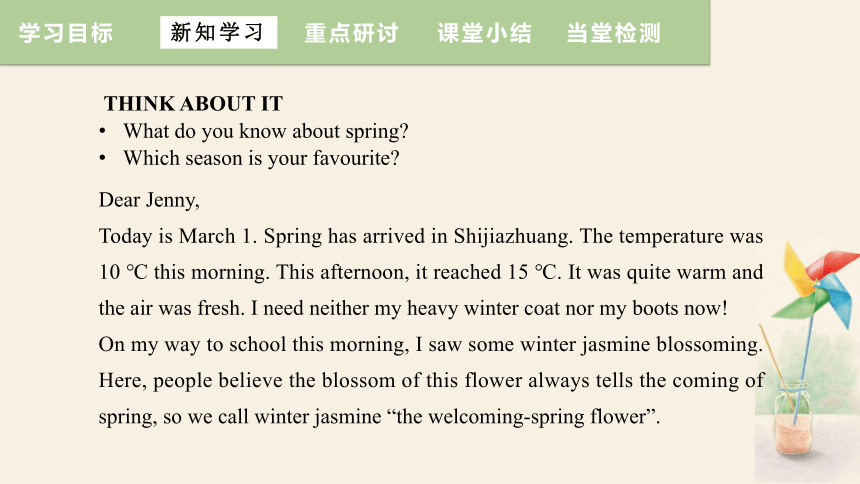
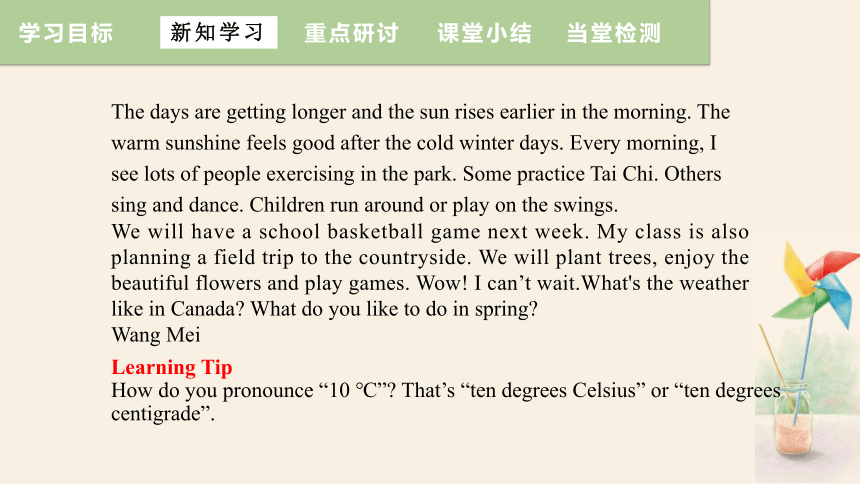
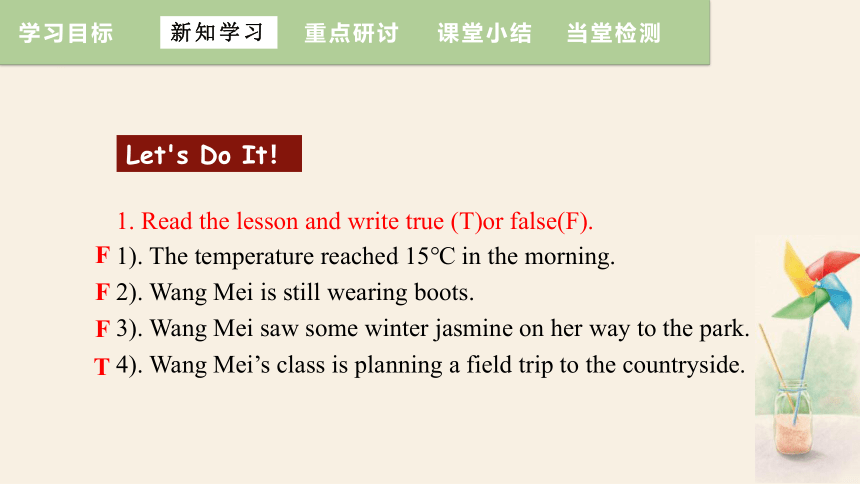
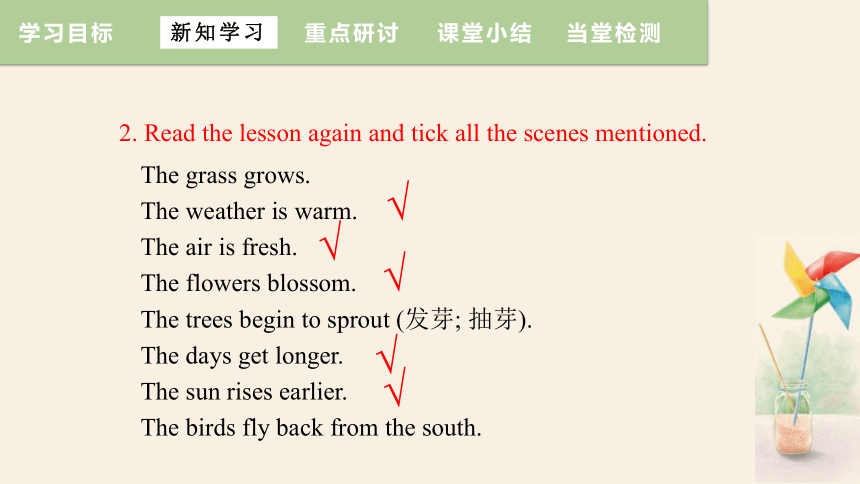
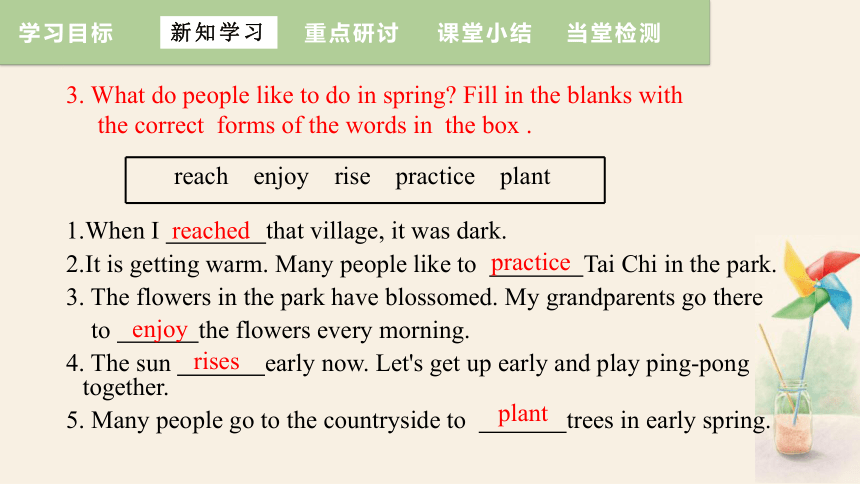
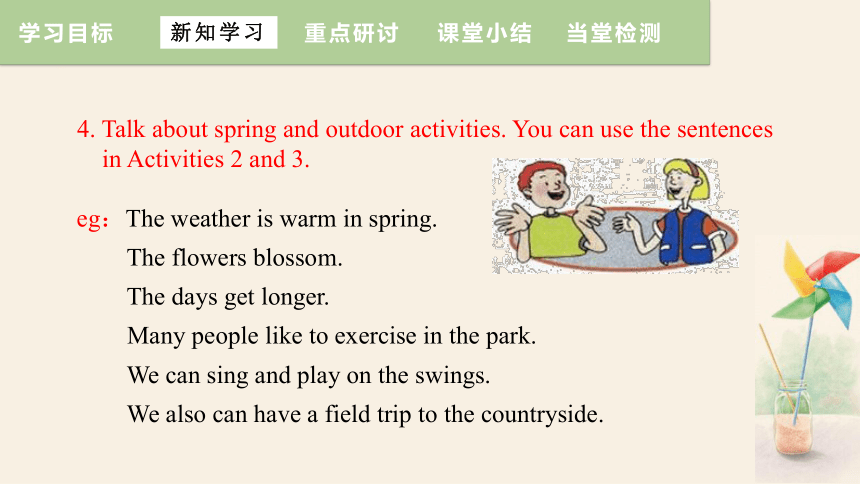
文档简介
(共20张PPT)
Unit 1 Spring Is Coming!
Lesson 2 It’s Getting Warmer!
新
课
导
入
What season is it
It’s spring.
Language Goal
新知学习
课堂小结
当堂检测
学习目标
重点研讨
1.能熟悉并能正确运用本课时的重点单词和短语
2.能掌握see/hear sb doing 和 see/hear sb do 这两种表达和区别
新知学习
课堂小结
当堂检测
学习目标
重点研讨
THINK ABOUT IT
What do you know about spring
Which season is your favourite
Dear Jenny,
Today is March 1. Spring has arrived in Shijiazhuang. The temperature was 10 ℃ this morning. This afternoon, it reached 15 ℃. It was quite warm and the air was fresh. I need neither my heavy winter coat nor my boots now!
On my way to school this morning, I saw some winter jasmine blossoming. Here, people believe the blossom of this flower always tells the coming of spring, so we call winter jasmine “the welcoming-spring flower”.
新知学习
课堂小结
当堂检测
学习目标
重点研讨
The days are getting longer and the sun rises earlier in the morning. The warm sunshine feels good after the cold winter days. Every morning, I see lots of people exercising in the park. Some practice Tai Chi. Others sing and dance. Children run around or play on the swings.
We will have a school basketball game next week. My class is also planning a field trip to the countryside. We will plant trees, enjoy the beautiful flowers and play games. Wow! I can’t wait.What's the weather like in Canada What do you like to do in spring
Wang Mei
Learning Tip
How do you pronounce “10 ℃” That’s “ten degrees Celsius” or “ten degrees centigrade”.
新知学习
课堂小结
当堂检测
学习目标
重点研讨
1. Read the lesson and write true (T)or false(F).
1). The temperature reached 15℃ in the morning.
2). Wang Mei is still wearing boots.
3). Wang Mei saw some winter jasmine on her way to the park.
4). Wang Mei’s class is planning a field trip to the countryside.
Let's Do It!
F
F
F
T
新知学习
课堂小结
当堂检测
学习目标
重点研讨
2. Read the lesson again and tick all the scenes mentioned.
The grass grows.
The weather is warm.
The air is fresh.
The flowers blossom.
The trees begin to sprout (发芽; 抽芽).
The days get longer.
The sun rises earlier.
The birds fly back from the south.
√
√
√
√
√
新知学习
课堂小结
当堂检测
学习目标
重点研讨
reach enjoy rise practice plant
1.When I that village, it was dark.
2.It is getting warm. Many people like to Tai Chi in the park.
3. The flowers in the park have blossomed. My grandparents go there
to the flowers every morning.
4. The sun early now. Let's get up early and play ping-pong together.
5. Many people go to the countryside to trees in early spring.
3. What do people like to do in spring Fill in the blanks with
the correct forms of the words in the box .
reached
practice
enjoy
rises
plant
新知学习
课堂小结
当堂检测
学习目标
重点研讨
4. Talk about spring and outdoor activities. You can use the sentences
in Activities 2 and 3.
eg:The weather is warm in spring.
The flowers blossom.
The days get longer.
Many people like to exercise in the park.
We can sing and play on the swings.
We also can have a field trip to the countryside.
新知学习
旧知回顾
课堂小结
当堂检测
学习目标
拓展提升
重点研讨
课堂小结
当堂检测
学习目标
新知学习
get 多用于口语,表示一种变化过程,
强调 “渐渐变得……”,后+adj.比较级
become 中性词,用于意义好、坏两方面的变化都可以,
多指身份、职位等的变化,强调变化的过程
已经完成,后+n./adj.
turn 指在颜色和性质等方面与以前完全不同,强调
变化的结果
1. get, become, turn 3个“变”的用法
重点研讨
课堂小结
当堂检测
学习目标
新知学习
2. neither 的词性和用法 conj. pron. adj. adv.
1). conj. 既不……也不……;两者都不……
常用结构:neither…nor…
反义短语:both…and… 或 not only…but also…
可连接平行的两个主语、谓语、宾语、表语等。
可连接平行的词、短语、句子。
重点研讨
课堂小结
当堂检测
学习目标
新知学习
Eg:
①她既不喜欢苹果,也不喜欢香蕉。(宾语)
She likes neither apples nor bananas.
②他不吃也不喝。(谓语)
He neither eats nor drinks.
③这双鞋既不太大,也不太小,刚好合适。
The shoes are neither too large nor too small.
They fit me well. (表语)
④今天爸妈都不在家。 (主语)
Neither dad nor mom is at home today.
重点研讨
课堂小结
当堂检测
学习目标
新知学习
注:连接两个主语(名词或代词)时,谓语动词的单复数应根据 就近原则,且用肯定形式。
即时练习:
① Neither my sister nor I ___ been to the USA before.
A. have ever B. have never
C. has ever D. has never
②Neither he nor I ____ well-educated.
A
am
重点研讨
课堂小结
当堂检测
学习目标
新知学习
2). pron. 二者都不;两者之中任何一个都不
neither作主语时,谓语动词一般用单数形式。
① Neither of us _______(喜欢) watching TV.
②他两份信一封都没回。
He answered neither of the letters.
likes
重点研讨
课堂小结
当堂检测
学习目标
新知学习
3). adj. “两者都不的”(修饰单数名词)
例:两个答案都不对。
Neither answer is right.
4). adv. “也不… ” = nor
(用于否定句之后,且要倒装)
例:He can’t swim. Neither/Nor can I.
他不会游泳,我也不会。
On my way to school this morning, I saw some winter jasmine blossoming. Every morning, I see lots
of people exercising in the park.
see sb. doing sth.
看见某人正在干某事
We saw her chatting with her neighbors.
我们看到她在和邻居聊天。
重点研讨
课堂小结
当堂检测
学习目标
新知学习
3. see sb. doing sth.
重点研讨
课堂小结
当堂检测
学习目标
新知学习
Spring has arrived in Shijiazhuang.
They will arrive in the city next week.
下周他们将到达那个城市。
They arrived at our school yesterday.
他们昨天到达了我们学校。
arrive in… 到达某地,通常指到达较大的地方;到达较小的地方用arrive at…比较:
4. arrive的用法
新知学习
旧知回顾
课堂小结
当堂检测
学习目标
拓展提升
课堂小结
重点研讨
当堂检测
学习目标
新知学习
重点词汇neither的用法
重点短语:
看到某人正在做某事
see sb doing sth
到达大、小地方
arrive in/at
表示变化的三个动词:
get,逐渐变化
become,身份变化
turn,颜色性质变化
Unit 1
Lesson 2
新知学习
旧知回顾
课堂小结
当堂检测
学习目标
拓展提升
当堂检测
重点研讨
课堂小结
学习目标
新知学习
用括号内单词的适当形式或汉语提示填空
1.When I walked past the park, I saw some old people
(do)Chinese Tai Chi.
2. She likes neither butter cheese(也不).
3. Neither he nor I a teacher(be).
4. Please write to me as soon as you arrive Shanghai(介词).
doing
am
nor
in
新知学习
旧知回顾
课堂小结
当堂检测
学习目标
拓展提升
当堂检测
重点研讨
课堂小结
学习目标
新知学习
5. The weather is cold and _________ (snow) in winter.
6. Some students like basketball,while (other)like football.
7. The day is getting _________ (long) and _________(long).
8. The weather in spring becomes _________(warm)
than that in winter.
snowy
others
warmer
longer
longer
Unit 1 Spring Is Coming!
Lesson 2 It’s Getting Warmer!
新
课
导
入
What season is it
It’s spring.
Language Goal
新知学习
课堂小结
当堂检测
学习目标
重点研讨
1.能熟悉并能正确运用本课时的重点单词和短语
2.能掌握see/hear sb doing 和 see/hear sb do 这两种表达和区别
新知学习
课堂小结
当堂检测
学习目标
重点研讨
THINK ABOUT IT
What do you know about spring
Which season is your favourite
Dear Jenny,
Today is March 1. Spring has arrived in Shijiazhuang. The temperature was 10 ℃ this morning. This afternoon, it reached 15 ℃. It was quite warm and the air was fresh. I need neither my heavy winter coat nor my boots now!
On my way to school this morning, I saw some winter jasmine blossoming. Here, people believe the blossom of this flower always tells the coming of spring, so we call winter jasmine “the welcoming-spring flower”.
新知学习
课堂小结
当堂检测
学习目标
重点研讨
The days are getting longer and the sun rises earlier in the morning. The warm sunshine feels good after the cold winter days. Every morning, I see lots of people exercising in the park. Some practice Tai Chi. Others sing and dance. Children run around or play on the swings.
We will have a school basketball game next week. My class is also planning a field trip to the countryside. We will plant trees, enjoy the beautiful flowers and play games. Wow! I can’t wait.What's the weather like in Canada What do you like to do in spring
Wang Mei
Learning Tip
How do you pronounce “10 ℃” That’s “ten degrees Celsius” or “ten degrees centigrade”.
新知学习
课堂小结
当堂检测
学习目标
重点研讨
1. Read the lesson and write true (T)or false(F).
1). The temperature reached 15℃ in the morning.
2). Wang Mei is still wearing boots.
3). Wang Mei saw some winter jasmine on her way to the park.
4). Wang Mei’s class is planning a field trip to the countryside.
Let's Do It!
F
F
F
T
新知学习
课堂小结
当堂检测
学习目标
重点研讨
2. Read the lesson again and tick all the scenes mentioned.
The grass grows.
The weather is warm.
The air is fresh.
The flowers blossom.
The trees begin to sprout (发芽; 抽芽).
The days get longer.
The sun rises earlier.
The birds fly back from the south.
√
√
√
√
√
新知学习
课堂小结
当堂检测
学习目标
重点研讨
reach enjoy rise practice plant
1.When I that village, it was dark.
2.It is getting warm. Many people like to Tai Chi in the park.
3. The flowers in the park have blossomed. My grandparents go there
to the flowers every morning.
4. The sun early now. Let's get up early and play ping-pong together.
5. Many people go to the countryside to trees in early spring.
3. What do people like to do in spring Fill in the blanks with
the correct forms of the words in the box .
reached
practice
enjoy
rises
plant
新知学习
课堂小结
当堂检测
学习目标
重点研讨
4. Talk about spring and outdoor activities. You can use the sentences
in Activities 2 and 3.
eg:The weather is warm in spring.
The flowers blossom.
The days get longer.
Many people like to exercise in the park.
We can sing and play on the swings.
We also can have a field trip to the countryside.
新知学习
旧知回顾
课堂小结
当堂检测
学习目标
拓展提升
重点研讨
课堂小结
当堂检测
学习目标
新知学习
get 多用于口语,表示一种变化过程,
强调 “渐渐变得……”,后+adj.比较级
become 中性词,用于意义好、坏两方面的变化都可以,
多指身份、职位等的变化,强调变化的过程
已经完成,后+n./adj.
turn 指在颜色和性质等方面与以前完全不同,强调
变化的结果
1. get, become, turn 3个“变”的用法
重点研讨
课堂小结
当堂检测
学习目标
新知学习
2. neither 的词性和用法 conj. pron. adj. adv.
1). conj. 既不……也不……;两者都不……
常用结构:neither…nor…
反义短语:both…and… 或 not only…but also…
可连接平行的两个主语、谓语、宾语、表语等。
可连接平行的词、短语、句子。
重点研讨
课堂小结
当堂检测
学习目标
新知学习
Eg:
①她既不喜欢苹果,也不喜欢香蕉。(宾语)
She likes neither apples nor bananas.
②他不吃也不喝。(谓语)
He neither eats nor drinks.
③这双鞋既不太大,也不太小,刚好合适。
The shoes are neither too large nor too small.
They fit me well. (表语)
④今天爸妈都不在家。 (主语)
Neither dad nor mom is at home today.
重点研讨
课堂小结
当堂检测
学习目标
新知学习
注:连接两个主语(名词或代词)时,谓语动词的单复数应根据 就近原则,且用肯定形式。
即时练习:
① Neither my sister nor I ___ been to the USA before.
A. have ever B. have never
C. has ever D. has never
②Neither he nor I ____ well-educated.
A
am
重点研讨
课堂小结
当堂检测
学习目标
新知学习
2). pron. 二者都不;两者之中任何一个都不
neither作主语时,谓语动词一般用单数形式。
① Neither of us _______(喜欢) watching TV.
②他两份信一封都没回。
He answered neither of the letters.
likes
重点研讨
课堂小结
当堂检测
学习目标
新知学习
3). adj. “两者都不的”(修饰单数名词)
例:两个答案都不对。
Neither answer is right.
4). adv. “也不… ” = nor
(用于否定句之后,且要倒装)
例:He can’t swim. Neither/Nor can I.
他不会游泳,我也不会。
On my way to school this morning, I saw some winter jasmine blossoming. Every morning, I see lots
of people exercising in the park.
see sb. doing sth.
看见某人正在干某事
We saw her chatting with her neighbors.
我们看到她在和邻居聊天。
重点研讨
课堂小结
当堂检测
学习目标
新知学习
3. see sb. doing sth.
重点研讨
课堂小结
当堂检测
学习目标
新知学习
Spring has arrived in Shijiazhuang.
They will arrive in the city next week.
下周他们将到达那个城市。
They arrived at our school yesterday.
他们昨天到达了我们学校。
arrive in… 到达某地,通常指到达较大的地方;到达较小的地方用arrive at…比较:
4. arrive的用法
新知学习
旧知回顾
课堂小结
当堂检测
学习目标
拓展提升
课堂小结
重点研讨
当堂检测
学习目标
新知学习
重点词汇neither的用法
重点短语:
看到某人正在做某事
see sb doing sth
到达大、小地方
arrive in/at
表示变化的三个动词:
get,逐渐变化
become,身份变化
turn,颜色性质变化
Unit 1
Lesson 2
新知学习
旧知回顾
课堂小结
当堂检测
学习目标
拓展提升
当堂检测
重点研讨
课堂小结
学习目标
新知学习
用括号内单词的适当形式或汉语提示填空
1.When I walked past the park, I saw some old people
(do)Chinese Tai Chi.
2. She likes neither butter cheese(也不).
3. Neither he nor I a teacher(be).
4. Please write to me as soon as you arrive Shanghai(介词).
doing
am
nor
in
新知学习
旧知回顾
课堂小结
当堂检测
学习目标
拓展提升
当堂检测
重点研讨
课堂小结
学习目标
新知学习
5. The weather is cold and _________ (snow) in winter.
6. Some students like basketball,while (other)like football.
7. The day is getting _________ (long) and _________(long).
8. The weather in spring becomes _________(warm)
than that in winter.
snowy
others
warmer
longer
longer
同课章节目录
- Unit 1 Spring Is Coming
- Lesson 1 How's the weather?
- Lesson 2 It's Getting Warmer!
- Lesson 3 Sun Is Rising
- Lesson 4 The Spring City
- Lesson 5 Babysitting on a Spring Day
- Lesson 6 Stories about Spring
- Unit 2 Plant a Plant
- Lesson 7 Planting Trees
- Lesson 8 Why Are Plants Important?
- Lesson 9 Gardening with Mary
- Lesson 10 Make Your Garden Grow!
- Lesson 11 Amazing Plants
- Lesson 12 Danny's Plant
- Unit 3 Animals Are Our Friends
- Lesson 13 Danny's Big Scare
- Lesson 14 Amazing Animals
- Lesson 15 The Zoo Is Open
- Lesson 16 The Pear Escaped
- Lesson 17 Save the Tigers
- Lesson 18 Friendship Between Animals
- Unit 4 The Internet Connects Us
- Lesson 19 How Do You Use the Internet?
- Lesson 20 A Computer Helps!
- Lesson 21 Books or Computers?
- Lesson 22 Travel on the Internet
- Lesson 23 The Internet--Good or Bad?
- Lesson 24 An E-mail to Grandpa
- Unit 5 Buying and Selling
- Lesson 25 Raising Money
- Lesson 26 Cookies, Please!
- Lesson 27 Business English
- Lesson 28 Ms. Liu's Great Idea
- Lesson 29 How to Push a Product
- Lesson 30 A Cookie Sale
- Unit 6 Be a Champion!
- Lesson 31 Don't Fall, Danny
- Lesson 32 My Favourite Record
- Lesson 33 2800 Years of Sports
- Lesson 34 Modern Olympics
- Lesson 35 The Dream Team
- Lesson 36 Classroom Olympics
- Unit 7 Know Our World
- Lesson 37 Let's Learn Geography!
- Lesson 38 The World Is a Big Place
- Lesson 39 Ring Up or Call?
- Lesson 40 Body Language
- Lesson 41 A Class of the World
- Lesson 42 North America
- Unit 8 Save Our World
- Lesson 43 Let's Clean Up!
- Lesson 44 Environment Clubs
- Lesson 45 Let's Sort Garbage!
- Lesson 46 Protect Our Environment
- Lesson 47 Connected to Nature
- Lesson 48 Garbage Is Interesting!
